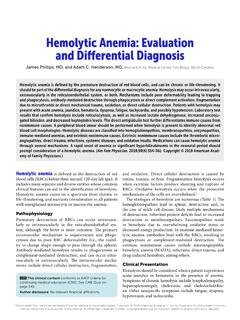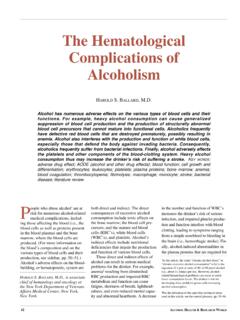Transcription of 2. Fat-Soluble Vitamins and Nutrients
1 871. Water-Soluble Vitamins872. Fat-Soluble Vitamins & Nutrients2. Fat-Soluble Vitamins and NutrientsVitamins A and E and Carotenoids Vitamin A Retinyl palmitate Retinyl stearate Vitamin E gamma-Tocopherol alpha-Carotene trans-beta-Carotene cis-beta-Carotene beta-Cryptoxanthin Lutein and zeaxanthin trans-Lycopene Total lycopene (cis- and trans-)Vitamin D 25-Hydroxyvitamin DFatty AcidsSaturated Myristic acid (14:0) Palmitic acid (16:0) Stearic acid (18:0) Arachidic acid (20:0) Docosanoic acid (22:0) Lignoceric acid (24:0)Monounsaturated Myristoleic acid (14:1n-5) Palmitoleic acid (16:1n-7) cis-Vaccenic acid (18:1n-7) Oleic acid (18:1n-9) Eicosenoic acid (20.)
2 1n-9) Docosenoic acid (22:1n-9) Nervonic acid (24:1n-9)Polyunsaturated Linoleic acid (18:2n-6) alpha-Linolenic acid (18:3n-3) gamma-Linolenic acid (18:3n-6) Eicosadienoic acid (20:2n-6) homo-gamma-Linolenic acid (20:3n-6) Arachidonic acid (20:4n-6) Eicosapentaenoic acid (20:5n-3) Docosatetraenoic acid (22:4n-6) Docosapentaenoic acid (22:5n-3) Docosapentaenoic acid (22:5n-6) Docosahexaenoic acid (22:6n-3)882nd National Report on Biochemical Indicators of Diet and Nutrition in the Population882nd National Report on Biochemical Indicators of Diet and Nutrition in the PopulationVitamins A, E and CarotenoidsBackground InformationSources and Physiological Functions.
3 Vitamins A (retinol) and E (alpha-tocopherol) and the carotenoids are Fat-Soluble micronutrients found in many foods, including some vegetables, fruits, meats, and animal products. Fish-liver oils, liver, egg yolks, butter, and cream are known for their higher content of vitamin A. Nuts and seeds are particularly rich sources of vitamin E (Thomas 2006). At least 700 carotenoids Fat-Soluble red and yellow pigments are found in nature (Britton 2004). Americans consume 40 50 of these carotenoids, primarily in fruits and vegetables (Khachik 1992), and smaller amounts in poultry products, including egg yolks, as well as in seafoods (Boylston 2007).
4 Eight different carotenoids are easily measured in human serum: alpha-carotene, cis- and trans-beta-carotene, beta-cryptoxanthin, lutein, cis- and trans-lycopene, and zeaxanthin. Main sources of carotenes are orange-colored fruits and vegetables such as carrots, pumpkins, and mangos. Lutein and zeaxanthin are also found in dark green leafy vegetables, where any orange coloring is overshadowed by chlorophyll. Trans-lycopene is obtained primarily from tomatoes and tomato products and some fruits. For information on the carotenoid content of foods, see the 1998 carotenoid database created by the Department of Agriculture and the Nutrition Coordinating Center at the University of Minnesota ( ).
5 Vitamin A, found in foods that come from animal sources, is called preformed vitamin A. Some carotenoids found in colorful fruits and vegetables are called provitamin A because they are metabolized in the body to vitamin A. Among the carotenoids, beta-carotene, a retinol dimer consisting of two linked retinol molecules, has the most significant provitamin A activity. Approximately 12 micrograms ( g) of dietary beta-carotene can provide the equivalent of 1 g of retinol. Other provitamin A carotenoids, such as alpha-carotene and beta-cryptoxanthin, are half as active as beta-carotene (Institute of Medicine 2000). The bioconversion of carotenoids to vitamin A is highly variable from person to person (Krinsky 2005).
6 Retinyl esters serve as the storage form of vitamin A and are mostly concentrated in the liver. The absorption of Fat-Soluble micronutrients from the gastrointestinal tract depends on processes responsible for fat absorption or metabolism. Thus, people with conditions resulting in fat malabsorption ( , celiac disease, Crohn s disease, pancreatic disorders) can develop vitamin A deficiency over time. Vitamin A also has interactions with other Nutrients . Iron and zinc deficiency can affect vitamin A metabolism and transport of vitamin A stores from the liver to body tissues (Institute of Medicine 2001). The absorption of carotenoids from foods is highly dependent on cooking techniques that break down plant cell walls and release carotenoids; it is also dependent on the availability of dietary fat to enhance carotenoid uptake (Krinsky 2005).
7 The liver regulates the concentration of vitamin A in the circulation by releasing stored retinyl esters as needed; only when liver reserves are nearly exhausted does serum vitamin A fall into the deficient range (Napoli 2006). The variation in serum carotenoid concentrations among people in the United States is relatively large, primarily reflecting wide-ranging differences in dietary intake (Lacher 2005).Vitamin E activity is derived from at least eight naturally occurring tocopherols, the most potent of which is alpha-tocopherol. Other less active forms of vitamin E are plentiful in the diet, with gamma-tocopherol being the predominant form.
8 The most commonly consumed sources of alpha-tocopherol in the diet of American adults are mixed foods (spaghetti sauce, pizza and chili), fried potatoes, salad dressings, and bakery goods (Ahuja 2004). Other important sources are 891. Water-Soluble Vitamins892. Fat-Soluble Vitamins & Nutrientstomatoes, eggs, nuts and seeds, and snack foods. Plasma concentrations of tocopherols vary widely among healthy individuals and are highly correlated with plasma lipid concentrations (Ford 1999; Ford 2006).Health Effects. Inadequate or excessive intake of Vitamins A or E can lead to various disorders. For example, vitamin A deficiency, considered to be the main cause of childhood blindness in low-income countries (Roodhooft 2002), is a rare condition in the United States.
9 Prominent signs of vitamin A deficiency include night blindness, corneal thinning, and conjunctival metaplasia. Vitamin A is also essential for proper immune function, epithelial growth and repair, bone growth, reproduction, and normal embryonic and fetal development (West 2006). Acute toxicity resulting from single or short-term large doses of preformed vitamin A is characterized by nausea, vomiting, headache, vertigo, blurred vision, increased cerebrospinal fluid pressure, and lack of muscular coordination. Central nervous system effects, liver abnormalities, bone and skin changes, and other nonspecific adverse effects can be indicative of chronic hypervitaminosis A.
10 Consuming excess amounts of vitamin A during early pregnancy may lead to serious birth defects (Institute of Medicine 2001). Serum or plasma concentrations of carotenoids are considered among the best biological markers for fruit and vegetable intake. The strongest dietary predictors of serum carotenoid concentrations are fruits (for sources of beta-cryptoxanthin), carrots and root vegetables (for sources of carotenes), and tomato products (for sources of trans-lycopene) (Al-Delaimy 2005). Research studies have shown inconsistencies in the relation between carotenoid intake and protection from cancer. Carotenoids in foods, even when consumed over long periods and in large amounts are not known to produce adverse health effects.












